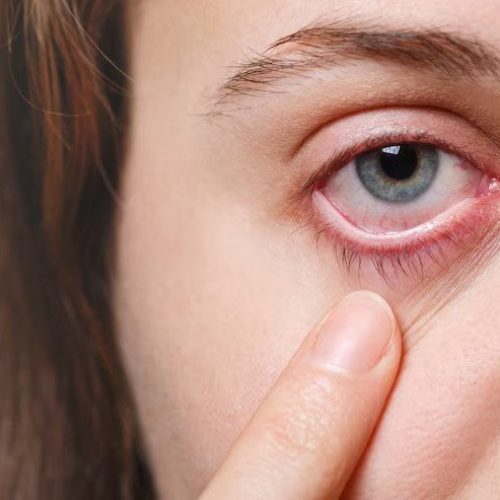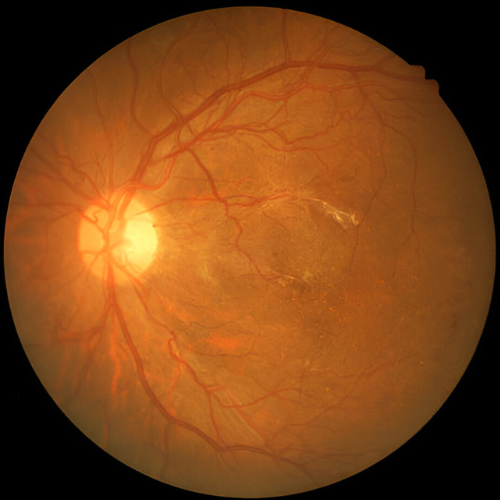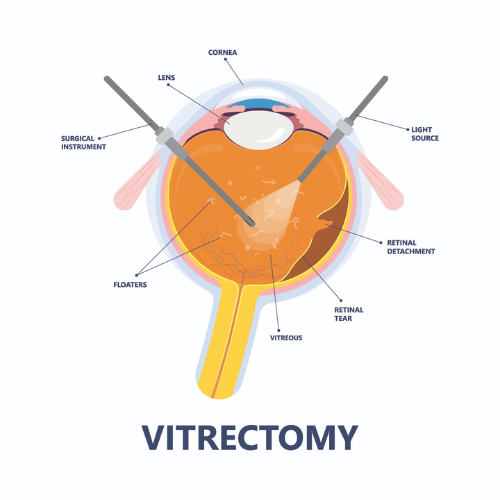
What is Diabetic Retinopathy
Diabetes can cause blood vessels to leak causing macular edema and abnormal blood vessel to grow and possibly bleed causing proliferative diabetic retinopathy (PDR). For effective Diabetic Retinopathy treatment in Undri, Kondhwa, NIBM, Pune visit Hi Tech Eye Surgery Center.
- Severity of DR runs parallel to the duration of DM
- 50% of Diabetics have DR after 10 years of DM
- 90% of Diabetics have DR after 20 years of DM
- A regular checkup every 6-12 months can detect early changes & prevent blindness.
What Symptoms Does Diabetic Retinopathy Causes?
Most people with diabetic retinopathy do not have any symptoms or visual loss due to their retinopathy. However, without treatment, diabetic retinopathy can gradually become worse and lead to visual loss or even blindness. Initial symptoms that may occur include blurred vision, seeing floaters and flashes, or even having a sudden loss of vision.
Test And Diagnosis
Macular edema and proliferative diabetic retinopathy can be accessed through a dilated eye exam. In addition, tests such as a fluorescein angiogram and ocular coherence tomography (OCT) can be conducted. Macular edema also can be assessed by using an OCT.
In some cases, advanced damage may be present without the patient even being aware. Also, most treatments for diabetic eye disease work better at preventing and controlling the diabetic retinopathy than at reversing it once it is well established. Because of this, it is very important for diabetics to have a regular, complete eye and retinal examination that should include drops to dilate the pupil.


How Is Diabetic Retinopathy Treated?
Treatment and Drugs
In mild cases, treatment for diabetic retinopathy is not necessary. Regular eye exams are critical for monitoring progression of the disease. Strict control of blood sugar and blood pressure levels can greatly reduce or prevent diabetic retinopathy. In more advanced cases, treatment is recommended to stop the damage of diabetic retinopathy, prevent vision loss, and potentially restore vision.
Treatment options include:
- Anti-VEGF therapy (Avastin, Lucentis, Ozurdex) Anti-VEGF therapy involves the injection of the medication into the back of your eye. The medication is an antibody designed to bind to and remove the excess VEGF (vascular endothelial growth factor) present in the eye that is causing the disease state. The FDA has approved Lucentis for macular edema and additional treatment options include Avastin and Ozurdex.
- Intraocular steroid injection: Intra-ocular steroid injection is a treatment for diabetic macular edema.
- Laser surgery : Retinal Laser Therapy
- How does laser surgery treat diabetic retinopathy?
Technique Of Laser Therapy (Laser Therapy for Diabetic Retinopathy)
Treatment is an outpatient procedure; admission to hospital is not required. The patient sits at a slit lamp similar to that used in routine ophthalmic examination but modified to accept a laser fibreoptic cable. Drops are used to anaesthetize the cornea and a therapeutic contact lens is applied. As treatment is started, the patient experiences bright flashes of light but no pain. The eye must be kept as still as possible during treatment to ensure accurate application of the laser and to avoid damage to the fovea; a typical treatment takes about ten minutes
Patient can communicate with the ophthalmologist in case of any discomfort; so that the treatment can be safely interrupted. Commonly the patient is very dazzled after the treatment, and sometimes the laser spots are visible to the patient. Typically though not invariably, this effect fades over the next few days. No special precautions need to be taken after the laser. Additional eye drops or oral therapy may be required in certain co are needed.


Vitrectomy
Vitrectomy may be recommended in advanced proliferative diabetic retinopathy. During this microsurgical procedure that is performed in the operating room, the blood-filled vitreous is removed and replaced with a clear solution. In addition to a vitrectomy, retinal repair may be necessary if scar tissue has detached the retina from the back of your eye. Severe loss of vision or even blindness can result if surgery is not performed to reattach the retina.
Retinal Vein Occlusion
Retinal vein occlusion occurs when one of the tiny retinal veins becomes blocked by a blood clot.Risk factors, apart from advanced age and genetic factors, are smoking, obesity, high blood pressure, diabetes and high cholesterol levels..The occlusion of the vein prevents the drainage of blood which results in haemorrhages and a swelling of the surrounding retina. In the long run the retina is irreversibly damaged.
There Are Two Main Types of Retinal Vein Occlusion?
- Branch retinal vein occlusion
- Central retinal vein occlusion
How Common Is Retinal Vein Occlusion And Who Gets It?
Retinal vein occlusion is a fairly common cause of vision loss. It is most common in people over the age of 60 and it seems to affect both sexes equally.
What Causes Retinal Vein Occlusion?
The exact reason why a blood clot may form in one of the retinal veins is not clear. However, there are some things that are thought to increase your risk of developing retinal vein occlusion. They include the following
- High blood pressure
- Diabetes
- Smoking
- Cardiac diseases (heart related diseases)
- Raised intraocular pressure (glaucoma)
What Are The Possible Complications Of Retinal Vein Occlusion?
Macular oedema: This is swelling of the macula at the centre of the retina.
Neovascularisation: This is abnormal new blood vessel formation at the back of the eye. About one third of people with retinal vein occlusion develop this problem which can sometimes lead to increased pressure within the eye and to glaucoma. Also, the new blood vessels are of a poor quality and can sometimes bleed.
What Are The Symptoms OF Retinal Vein Occlusion?
If you have retinal vein occlusion, you will usually notice painless decrease in vision in one eye or blind spot in one eye. Depending on the severity and also the degree of involvement of the macula, retinal vein occlusions may cause only mild visual loss. However, in some cases they may cause very profound visual loss.
How Is Retinal Vein Occlusion Diagnosed?
Retinal vein occlusion is usually diagnosed after an eye specialist (an ophthalmologist) examines the back of your eye, using an ophthalmoscope. The retina at the back of your eye has a typical appearance in retinal vein occlusion. Your specialist may advise some other tests or examinations to help to see how much damage has occurred to your retina. The tests may include:
- Special photographs of your retina.
- Fluorescein angiography
- Optical coherence tomography
What Is The Treatment For Retinal Vein Occlusion?
Currently, there is no treatment that can reverse the blocked vein. The aims of treatment are to detect and treat any underlying risk factors for the condition and also to detect and treat any complications where possible.
Treatment of any complications
Someone with retinal vein occlusion needs close follow-up so that any complications can be picked up early and treated where possible.
Anti-VEGF therapy (Avastin, Lucentis, Ozurdex)
Anti-VEGF therapy involves the injection of the medication into the back of your eye. The medication is an antibody designed to bind to and remove the excess VEGF (vascular endothelial growth factor) present in the eye that is causing the disease state. The FDA has approved Lucentis for macular edema and additional treatment options include Avastin and Ozurdex.
What Is The Outlook(Prognosis)?
Frequently Asked Questions

Hi Tech Eye Surgery Center
Eye Services – That You Can Trust
Cataract and Premium Lens Implant
Children’s Eye Check-up

Glaucoma Screening
Comprehensive Eye Examination
WHY CHOOSE Hi Tech Eye Surgery Center For Retina Treatment in Pune
The hospital has trained and experienced optometrists, nursing staff and machine operators to assist the doctors. The non-medical staff members are also well versed in hospital and patient management.
Medical ailments often cause stress and anxiety. At Hi Tech Eye Surgery Center we work to create a friendly environment which can help our patients to relax and communicate their concerns freely.
MEL-90 the world’s fastest Lasik machine, YAG laser for opacities and iridectomies, Green Laser Visulas from Carl Zeiss and several other sophisticated machines are a part of the Hi Tech Eye Surgery Center.
We are located on Parmar Pawan, Kondhwa Road, Opposite ICICI Bank, Fakhri Hills, Kondhwa,, one of the central roads in Pune. By-lanes in the vicinity ensure sufficient parking space.
An opticals facility and a medical shop are housed in the same premises for the convenience of our patients. These facilities enable our patients to get a complete solution.
Contact Hi Tech Eye Surgery Center
Get in touch with Hi Tech Eye Surgery Center for expert eye care and advanced laser treatments.
We are committed to delivering top-notch care to our patients, and we value your feedback as it plays a crucial role in enhancing our services and ensuring continuous improvement.
Request a Consultation
Contact Form
Experience the Best Eye Care at Hi Tech Eye Surgery Center
Book your appointment today and see the difference. if you have any questions call us on 020 2683 5088 / +917420817072 / +918448448946

